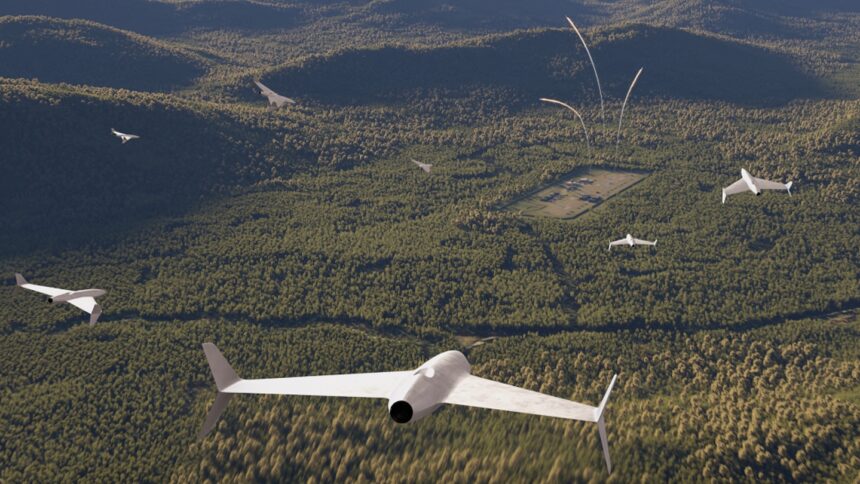I stood at the edge of a nondescript field somewhere in Western Ukraine, watching a Ukrainian technical operator prepare what looked like a hobbyist drone fitted with a warhead. “This one can fly 700 kilometers,” he told me, adjusting the navigation system with practiced precision. “Last month, we hit an oil refinery deep inside Russia with its brother.” The homemade aerial weapon would soon join hundreds of others in Ukraine’s increasingly sophisticated drone campaign against Russian military infrastructure.
The success of these low-cost, high-impact weapons hasn’t gone unnoticed in European defense circles. Across the continent, defense ministries and arms manufacturers are racing to develop their own versions of what Ukraine has demonstrated can fundamentally alter modern warfare—cheap, expendable drones capable of striking deep behind enemy lines.
France, Germany, Spain, and several other European nations have launched accelerated development programs for what they term “one-way attack systems“—essentially kamikaze drones similar to Iran’s Shahed-136 models that Russia has deployed against Ukrainian cities, but with Western technological enhancements.
“What we’re seeing is the democratization of precision strike capability,” explained Camille Grand, former NATO Assistant Secretary General for Defense Investment, during our conversation in Brussels last week. “European defense planners recognized that these systems provide strategic capabilities at a fraction of the cost of traditional missiles.”
According to intelligence assessments from the European Defence Agency that I reviewed, at least seven European countries have active development programs that would have been considered low-priority before February 2022. The war in Ukraine changed everything.
The French defense procurement agency DGA recently awarded a €350 million contract to Thales and MBDA for the “Colibri” program—a long-range loitering munition system designed to penetrate sophisticated air defenses. Unlike traditional cruise missiles costing millions per unit, these systems aim for price points under €200,000 each.
“We observed how Ukrainian forces successfully targeted Russian logistics, command posts, and air defense systems with converted commercial drones,” a senior French defense official told me, speaking on condition of anonymity. “Our systems will incorporate more sophisticated guidance and electronic warfare protection, but the fundamental concept remains the same.”
German defense contractor Rheinmetall has partnered with Israeli drone specialists to develop what they’ve termed the “Einstatz” system—a medium-range attack drone specifically designed for defeating armored vehicles and fortified positions. The program received a €270 million development injection following a special parliamentary authorization in December 2023.
Walking through Rheinmetall’s demonstration facility outside Munich earlier this year, I observed technicians testing composite materials designed to minimize radar signatures. “The Ukraine conflict showed us that survivability against modern air defense requires a combination of small size, low electromagnetic signature, and swarming capabilities,” explained Dr. Klaus Müller, head of Rheinmetall’s unmanned systems division.
The European focus extends beyond simply copying Iranian or Ukrainian designs. Spanish defense firm SENER has developed the RAPAZ system—a loitering munition that can be recovered if a mission is aborted, reducing costs and enabling training with the same platforms that would be used in combat.
Analysts from the Royal United Services Institute estimate that one-way attack drones cost between 5-10% of comparable cruise missiles while achieving similar operational effects against many targets. “The cost-exchange ratio is revolutionary,” defense economist Martin Lundqvist told me during a conference in Stockholm. “European militaries can afford to deploy these systems at scale, which changes the calculus of deterrence.”
NATO‘s Defense Innovation Accelerator for the North Atlantic (DIANA) has made kamikaze drone development a priority area for funding, with €80 million allocated specifically for advancing autonomous navigation and electronic warfare resilience. According to DIANA’s internal assessment documents, these capabilities represent “the most significant tactical innovation since precision-guided munitions.”
However, concerns remain about proliferation risks. The same technologies that make these weapons attractive to European militaries make them dangerous in the wrong hands. “We need to develop these systems while simultaneously creating countermeasures,” warned Alexandra Marksteiner of the Stockholm International Peace Research Institute. “The barrier to entry for non-state actors to acquire similar capabilities is decreasing rapidly.”
The European Union‘s diplomatic service has begun preliminary discussions on export control frameworks specific to one-way attack drones, according to diplomatic cables I’ve reviewed. The question of who should access this technology has become increasingly fraught as more countries develop indigenous capabilities.
For Ukrainian drone operators on the frontlines, these European development efforts represent validation of their improvised approach. “We built these systems out of necessity with consumer parts and determination,” said Yuriy, a Ukrainian drone unit commander I interviewed near Kharkiv. “Now defense giants are copying our designs, but with hundred-million-euro budgets.“
European defense officials emphasize that their systems will incorporate safeguards absent from Iranian and Russian models. “Our development includes stringent targeting protocols and fail-safes to minimize civilian casualties,” insisted a senior advisor to the EU’s High Representative for Foreign Affairs.
As Europe’s military-industrial complex pivots toward these weapons, the continent’s defense posture is evolving toward what some strategists call “distributed lethality“—the ability to threaten adversaries across broad areas without concentrating expensive platforms.
“The next European conflict will see thousands of these systems employed simultaneously,” predicted General Henri Bentégeat, former Chairman of the EU Military Committee, during a closed-door seminar I attended in Paris. “Traditional air superiority concepts must be entirely reconsidered.”
As I watched that Ukrainian drone disappear into the distance on its one-way mission, I couldn’t help but reflect on how this improvised weapon represented not just Ukraine’s resistance, but Europe’s military future taking flight before my eyes.






